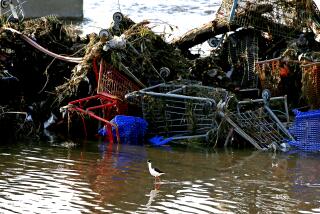Bacteria, Fungi Cause Infections : Germs Lurk in Hot Tubs, Study Finds
- Share via
Two years ago, a La Jolla man was stricken with an amoeba-caused eye infection, and doctors, initially puzzled about the source of the microorganism, finally traced it to the man’s backyard hot tub.
The situation captured the fancy of Charles Gonaver, a county health department microbiologist and a hot tub aficionado himself. Gonaver decided to study hot tubs--and the diseases they might potentially breed--for his master’s thesis in public health at San Diego State University.
Since September, Gonaver has visited 50 public hot tubs in San Diego, in hotels, condominiums, apartments and health clubs. Thirty of them failed to meet state standards for acid and chlorine levels and total bacteria in the water, and 18 of those had a thin scum, resembling a bathtub ring, on their walls and bottom.
Gonaver worked on his own time, but he shared his results with the county. Ray Redmond, a spokesman for the county Health Department, said each of the spas found to be in violation of state standards has been reinspected by the county and now is up to code.
Gonaver insists there is no cause for alarm, but in his research he discovered that all kinds of vile organisms might be lurking even in seemingly clean hot tubs, including bacteria and fungi that can cause skin, ear, eye and urinary tract infections; an amoeba that can infect the eyes and ears, and a mild form of Legionnaires’ Disease called Pontiac fever that results in upper respiratory infection.
Along with Christopher Peter, assistant chief of the county public health laboratory, Gonaver presented his findings to the annual meeting of the American Society of Microbiology this week in Las Vegas.
“It is well known that hot tubs can cause or aggravate certain skin diseases,” Gonaver said. “But nobody had ever looked into the potential they had for causing other problems. Hopefully, this can help be a preventive measure so this never does become a serious problem.”
Gonaver, 35, a 10-year county employee with a bachelor’s degree from Iowa State University, said he expects to complete his thesis before summer.
“We really can’t be certain what the health risk from hot tubs is, and we didn’t run across any situations where the hot tubs actually had to be shut down,” Gonaver said. “But since they’re increasingly popular across the country, we knew there would be a lot of interest in this area.”
The county inspects public hot tubs twice each year to ensure they are meeting sanitary standards. “Often we’ll find a minor violation, and the owner is asked to correct it before we come back to reinspect,” Redmond said. “It’s not a serious health problem--we’ve never had to close one down permanently.”
Peter said the study underscored the need to maintain and clean a hot tub, even if it is being treated with the recommended amounts of chlorine.
“We see no need for alarm since the organisms we found are in our environment every day,” Peter said in addressing the microbiologists in Las Vegas. “And we should remember that hot tubs and spas have not often been associated with outbreaks of disease in the past.
“But there is a potential for contacting disease in a hot tub, and we suspect the potential might be even greater in private tubs, which are not subject to the same inspection standards as public ones are.”






